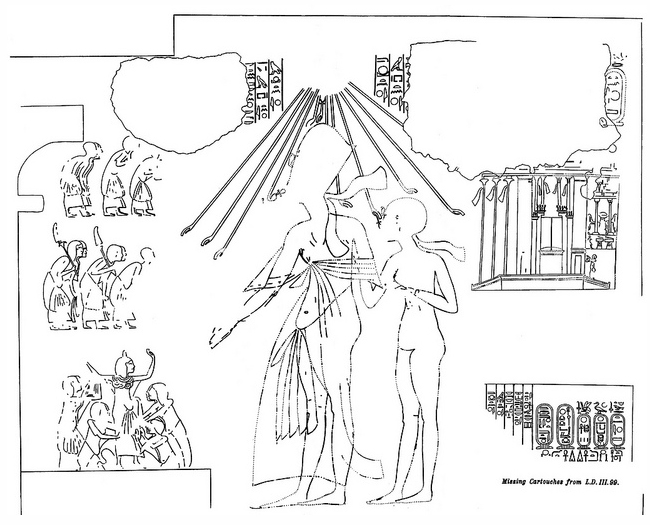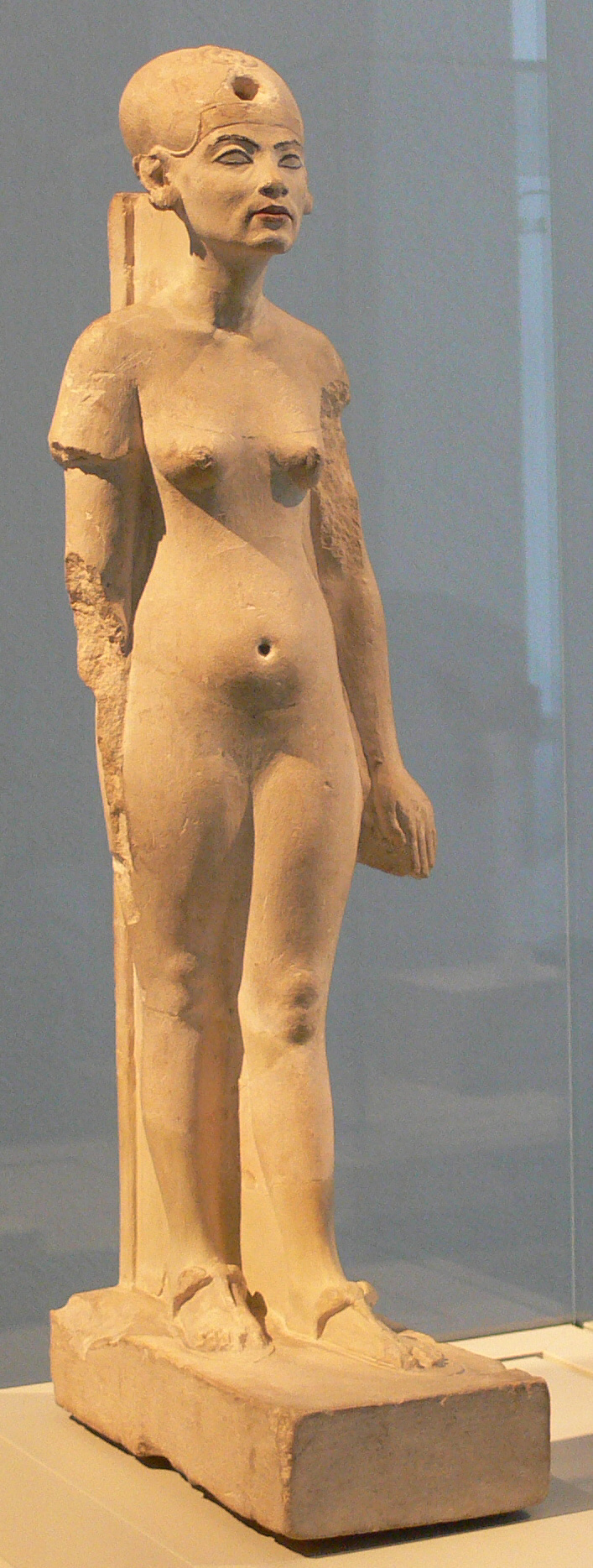|
Amarna Succession
The succession of kings at the end of the Eighteenth Dynasty of Ancient Egypt is a matter of great debate and confusion. There are very few contemporary records that can be relied upon, due to the nature of the Amarna Period and the reign of Akhenaten and his successors and possible co-regents. It is known that Akhenaten reigned for seventeen years, and it was previously believed that in the last 3 or 4 years, he had two co-regents: Smenkhkare, who was possibly his brother or son, and Neferneferuaten, who was either one of his daughters or his Great Royal Wife Nefertiti. It is unknown in which order they followed each other, and neither of their reigns lasted long, for Tutankhamun succeeded not long after Akhenaten's death. The last dated appearance of Akhenaten and the Amarna family is in the tomb of Meryre II, and dates from second month, year 12 of his reign. After this the historical record is unclear, and only with the succession of Tutankhamun is it somewhat clarified. How ... [...More Info...] [...Related Items...] OR: [Wikipedia] [Google] [Baidu] |
Amarna Period
The Amarna Period was an era of History of Ancient Egypt, Egyptian history during the later half of the Eighteenth dynasty of Egypt, Eighteenth Dynasty when the royal residence of the pharaoh and his queen was shifted to Akhetaten ('Horizon of the Aten') in what is now Amarna. It was marked by the reign of Amenhotep IV, who changed his name to Akhenaten (1353–1336 BC) in order to reflect the dramatic change of Ancient Egyptian religion, Egypt's polytheistic religion into one where the sun disc Aten was worshipped over all other gods. The Egyptian pantheon was restored under Akhenaten's successor, Tutankhamun. Religious developments Akhenaten instigated the earliest verified expression of a form of monotheism, although the origins of a pure monotheism are the subject of continuing debate within the academic community. Some state that Akhenaten restored monotheism while others point out that he merely suppressed a dominant solar cult by the assertion of another, while never complet ... [...More Info...] [...Related Items...] OR: [Wikipedia] [Google] [Baidu] |
Akhenaten
Akhenaten (pronounced ), also spelled Echnaton, Akhenaton, ( egy, ꜣḫ-n-jtn ''ʾŪḫə-nə-yātəy'', , meaning "Effective for the Aten"), was an ancient Egyptian pharaoh reigning or 1351–1334 BC, the tenth ruler of the Eighteenth Dynasty. Before the fifth year of his reign, he was known as Amenhotep IV ( egy, jmn-ḥtp, links=no, meaning "Amun is satisfied", Hellenized as ''Amenophis IV''). As a pharaoh, Akhenaten is noted for abandoning Egypt's traditional polytheism and introducing Atenism, or worship centered around Aten. The views of Egyptologists differ as to whether the religious policy was absolutely monotheistic, or whether it was monolatry, syncretistic, or henotheistic. This culture shift away from traditional religion was reversed after his death. Akhenaten's monuments were dismantled and hidden, his statues were destroyed, and his name excluded from lists of rulers compiled by later pharaohs. Traditional religious practice was gradually restored, not ... [...More Info...] [...Related Items...] OR: [Wikipedia] [Google] [Baidu] |
Smenkhkare
Smenkhkare (alternatively romanized ''Smenkhare'', ''Smenkare,'' or ''Smenkhkara''; meaning "'Vigorous is the Soul of Re") was an ancient Egyptian pharaoh of unknown background who lived and ruled during the Amarna Period of the 18th Dynasty. Smenkhkare was husband to Meritaten, the daughter of his likely co-regent, Akhenaten. Very little is known of Smenkhkare for certain because later kings sought to erase the Amarna Period from history. Because of this, perhaps no one from the Amarna Interlude has been the subject of so much speculation as Smenkhkare. Origin and family Smenkhkare's origins are unknown. It is assumed he was a member of the royal family, likely either a brother or son of the pharaoh Akhenaten. If he is Akhenaten's brother, his mother was likely either Tiye or Sitamun. If a son of Akhenaten, he was presumably an older brother of Tutankhamun, as he succeeded the throne ahead of him; his mother was likely an unknown, lesser wife. An alternative suggestion, base ... [...More Info...] [...Related Items...] OR: [Wikipedia] [Google] [Baidu] |
Neferneferuaten
Ankhkheperure-Merit-Neferkheperure/Waenre/Aten Neferneferuaten ( egy, nfr-nfrw-jtn) was a name used to refer to a female pharaoh who reigned toward the end of the Amarna Period during the Eighteenth Dynasty. Her sex is confirmed by feminine traces occasionally found in the name and by the epithet ''Akhet-en-hyes'' ("Effective for her husband"), incorporated into one version of her nomen (birth name) cartouche. She is distinguished from the king Smenkhkare who used the same throne name, Ankhkheperure, by the presence of epithets in both cartouches. She is suggested to have been either Meritaten or, more likely, Nefertiti. If this person is Nefertiti ruling as sole pharaoh, it has been theorized by Egyptologist and archaeologist Dr. Zahi Hawass that her reign was marked by the fall of Amarna and relocation of the capital back to the traditional city of Thebes. General chronology There is no broad consensus as to the succession order of Smenkhkare and Neferneferuaten. The per ... [...More Info...] [...Related Items...] OR: [Wikipedia] [Google] [Baidu] |
Nefertiti
Neferneferuaten Nefertiti () ( – c. 1330 BC) was a queen of the 18th Dynasty of Ancient Egypt, the great royal wife of Pharaoh Akhenaten. Nefertiti and her husband were known for a radical change in national religious policy, in which they promoted a form of proto-monotheism centred on the sun god Aten. With her husband, she reigned at what was arguably the wealthiest period of ancient Egyptian history. Some scholars believe that Nefertiti ruled briefly as Neferneferuaten after her husband's death and before the ascension of Tutankhamun, although this identification is a matter of ongoing debate.Dodson, Aidan, Amarna Sunset: ''Nefertiti, Tutankhamun, Ay, Horemheb, and the Egyptian Counter-Reformation''. The American University in Cairo Press. 2009, . If Nefertiti did rule as Pharaoh, her reign was marked by the fall of Amarna and relocation of the capital back to the traditional city of Thebes. She was made famous by her bust, now in Berlin's Neues Museum. The ... [...More Info...] [...Related Items...] OR: [Wikipedia] [Google] [Baidu] |
Tomb Of Meryra II
Meryre II was an ancient Egyptian noble known as the superintendent of Queen Nefertiti, and held the title of royal scribe, steward, overseer of the two treasuries, overseer of the royal harem of Nefertiti. He had a tomb constructed at Amarna, although his remains have never been identified. The tomb has the last dated appearance of Akhenaten and the Amarna family. Tomb of Meryra II The tomb of Meryra II is the royal sepulcher known as Amarna Tomb 2. The tomb dates back to the 18th Dynasty.Davies, Norman de Garis. The Rock Tombs of El Amarna. Part II – The Tomb of Panehesy and Meryra II. London, 1905. Facsimile iInternet Archive Egypt Exploration Society (2004) It is located in the northern side of the wadi that splits the cluster of tombs known collectively as the Northern tombs, near to the city of Amarna, Egypt. The tomb has been largely destroyed. It was decorated with the last dated appearance of Akhenaten and the Amarna family, dating from the second month, ye ... [...More Info...] [...Related Items...] OR: [Wikipedia] [Google] [Baidu] |
Tutankhamun
Tutankhamun (, egy, twt-ꜥnḫ-jmn), Egyptological pronunciation Tutankhamen () (), sometimes referred to as King Tut, was an Egyptian pharaoh who was the last of his royal family to rule during the end of the Eighteenth Dynasty (ruled in the conventional chronology) during the New Kingdom of Egyptian history. His father is believed to be the pharaoh Akhenaten, identified as the mummy found in the tomb KV55. His mother is his father's sister, identified through DNA testing as an unknown mummy referred to as "The Younger Lady" who was found in KV35. Tutankhamun took the throne at eight or nine years of age under the unprecedented viziership of his eventual successor, Ay, to whom he may have been related. He married his paternal half-sister Ankhesenamun. During their marriage they lost two daughters, one at 5–6 months of pregnancy and the other shortly after birth at full-term. His names—''Tutankhaten'' and ''Tutankhamun''—are thought to mean "Living image of At ... [...More Info...] [...Related Items...] OR: [Wikipedia] [Google] [Baidu] |
Season Of The Inundation
The Season of the Inundation or Flood ( egy, Ꜣḫt) was the first season of the lunar and civil Egyptian calendars. It fell after the intercalary month of Days over the Year ('). and before the Season of the Emergence ('). In the modern Coptic Calendar, this season lasts from Paoni 12 to Paopi 9. Names The pronunciation of the ancient Egyptian name for the Season of the Inundation is uncertain as the hieroglyphs do not record its vowels. It is conventionally transliterated Akhet. The name refers to the annual flooding of the Nile. Lunar calendar In the lunar calendar, the intercalary month was added as needed to maintain the heliacal rising of Sirius in the fourth month of the season of the Harvest. This meant that the Season of the Inundation usually lasted from September to January. Because the precise timing of the flood varied, the months of "Inundation" no longer precisely reflected the state of the river but the season was usually the time of the annual flooding. ... [...More Info...] [...Related Items...] OR: [Wikipedia] [Google] [Baidu] |
Deir El-Bersha
Deir El Bersha ( ar, دير البرشا; also written as Dayr al-Barsha, Deir el-Bersheh) is a Coptic village in Middle Egypt, in the Minya Governorate. It is located on the east bank of the Nile to the south of Antinoöpolis and almost opposite the city of Mallawi. During the pharaonic period, there was a vast cemetery, which is most well known for its decorated Middle Kingdom tombs on the north flank of Wadi Nakhla. Overview Dayr al-Barsha necropolis is near the Nile valley town of Minya, 225 km south of Cairo. An elite cemetery Middle Kingdom on the North Hill (referred to as Zone 2) is the most well known area of the necropolis. During the Middle Kingdom, it was the cemetery of the governors ("nomarchs") of the Hare Nome, the 15th Upper Egyptian Nome. It contains several spectacular rock-cut tombs, one of the most famous being that of the nomarch, Djehutihotep. Several of these tombs were destroyed by ancient quarrying and looting, including some for construction at ... [...More Info...] [...Related Items...] OR: [Wikipedia] [Google] [Baidu] |
KV62
The tomb of Tutankhamun, also known by its tomb number, KV62, is the burial place of Tutankhamun (reigned c. 1334–1325 BC), a pharaoh of the Eighteenth Dynasty of ancient Egypt, in the Valley of the Kings. The tomb consists of four chambers and an entrance staircase and corridor. It is smaller and less extensively decorated than other Egyptian royal tombs of its time, and it probably originated as a tomb for a non-royal individual that was adapted for Tutankhamun's use after his premature death. Like other pharaohs, Tutankhamun was buried with a wide variety of funerary objects and personal possessions, such as coffins, furniture, clothing and jewellery, though in the unusually limited space these goods had to be densely packed. Robbers entered the tomb twice in the years immediately following the burial, but Tutankhamun's mummy and most of the burial goods remained intact. The tomb's low position, dug into the floor of the valley, allowed its entrance to be hidden by debris de ... [...More Info...] [...Related Items...] OR: [Wikipedia] [Google] [Baidu] |






